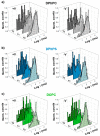Lipid Headgroup Charge and Acyl Chain Composition Modulate Closure of Bacterial β-Barrel Channels
- PMID: 30764475
- PMCID: PMC6386941
- DOI: 10.3390/ijms20030674
Lipid Headgroup Charge and Acyl Chain Composition Modulate Closure of Bacterial β-Barrel Channels
Abstract
The outer membrane of Gram-negative bacteria contains β-barrel proteins that form high-conducting ion channels providing a path for hydrophilic molecules, including antibiotics. Traditionally, these proteins have been considered to exist only in an open state so that regulation of outer membrane permeability was accomplished via protein expression. However, electrophysiological recordings show that β-barrel channels respond to transmembrane voltages by characteristically switching from a high-conducting, open state, to a so-called 'closed' state, with reduced permeability and possibly exclusion of large metabolites. Here, we use the bacterial porin OmpF from E. coli as a model system to gain insight on the control of outer membrane permeability by bacterial porins through the modulation of their open state. Using planar bilayer electrophysiology, we perform an extensive study of the role of membrane lipids in the OmpF channel closure by voltage. We pay attention not only to the effects of charges in the hydrophilic lipid heads but also to the contribution of the hydrophobic tails in the lipid-protein interactions. Our results show that gating kinetics is governed by lipid characteristics so that each stage of a sequential closure is different from the previous one, probably because of intra- or intermonomeric rearrangements.
Keywords: bacterial porins; beta-barrel channel; hydrophobic acyl chains; lipid headgroup charge; phospholipids; voltage gating.
Conflict of interest statement
The authors declare no conflict of interest. The funders had no role in the design of the study; in the collection, analyses, or interpretation of data; in the writing of the manuscript, or in the decision to publish the results.
Figures





References
-
- Aidley D.J., Stanfield P.R. 1st ed. Cambridge University Press; New York, NY, USA: 1996. Ion Channels: Molecules in Action.
-
- Hille B. Ion Channels of Excitable Membranes. 3rd ed. Sinauer Associates Inc.; Sunderland, MA, USA: 2001.
-
- Nestorovich E.M., Bezrukov S.M. Voltage-induced “gating” of bacterial porin as reversible protein denaturation. In: Abbott D., Bezrukov S.M., Der A., Sanchez A., editors. Proceedings of the SPIE 5467, Fluctuations and Noise in Biological, Biophysical, and Biomedical Systems II; Gran Canaria Island, Spain. 26–28 May 2004; 2004. p. 42.
MeSH terms
Substances
Grants and funding
LinkOut - more resources
Full Text Sources
Molecular Biology Databases

